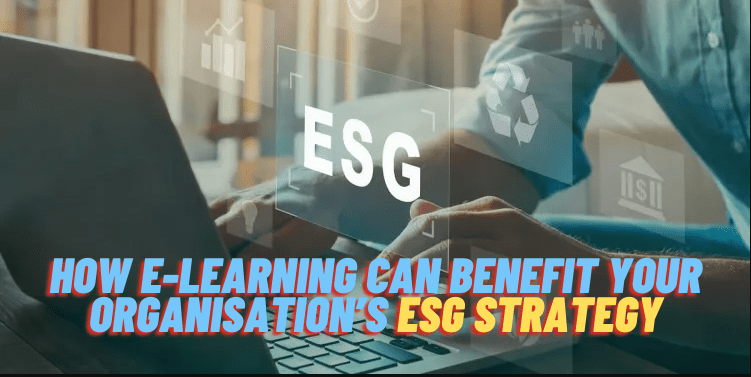How E-Learning Can Benefit Your Organisation’s ESG Strategy
ESG – Environmental, Social, and Governance – is becoming an increasingly important topic for organisations in a range of industries. How can you make sure there is alignment between your organisation’s ESG strategy and the day-to-day operation of your business? How can you ensure senior leadership buy-in with your ESG strategy? And how can you improve ESG knowledge and awareness across all levels of the organisation? E-learning can play a significant role in achieving your ESG goals and objectives.
E-learning can make ESG relevant to individuals at all levels of your organisation. E-learning courses on ESG topics can also help to reduce risks and improve financial performance. More on these points later. First, a quick recap on ESG and why it is important.
What is ESG?
-
- Environmental – the environmental part of ESG is concerned with steps the company takes to protect the environment and minimise the environmental impact of its operations. This covers everything from carbon emissions to waste management to sustainability in the supply chain.
-
- Social – the social part of ESG looks at how the company manages and handles relationships with its employees, suppliers, partners, and customers, as well as the relationships it has with the communities where it operates.
-
- Governance – governance in ESG covers the openness and transparency of the organisation, in addition to how it handles areas like leadership, internal controls, health and safety, audits, shareholders, executive pay, business practices, bribery, and corruption.
Why is ESG Important?
Many ESG topics are covered by laws and regulations, so ESG is important for compliance.
ESG is about much more than compliance, however, as topic areas that come under the ESG umbrella are increasingly scrutinised and prioritised by investors, customers, and other stakeholders, including employees.
In other words, ESG is about alignment. For example, companies increasingly want to ensure suppliers have ESG strategies that are aligned with their own. Employees are another example, particularly younger employees who increasingly want the companies they work for to share similar values to their own.
It’s also important to mention the media, as it is now commonplace for journalists and others in the media to scrutinise companies and organisations on ESG topics.
How E-Learning Benefits and Enhances Your ESG Strategy
Providing e-learning training on ESG topics will bring a range of benefits to your organisation, including:
Effectively communicating the importance of ESG across the organisation
ESG typically starts as a board-level issue, so it’s essential to have a plan to communicate board-level thinking to all other parts of the organisation. E-learning can help.
ESG strategy awareness
ESG e-learning helps ensure each person understands the organisation’s ESG strategy and areas of priority.
Personal responsibility
ESG e-learning helps ensure each person understands the role they play in delivering the organisation’s ESG strategy and achieving its goals. There is often a disconnect between individuals and some ESG topics, where employees struggle to see where they fit in. E-learning ESG courses can help to break this disconnect, making the topic relevant to the employee and showing how they make an impact.
Makes ESG training engaging, interesting, and memorable
This point should not be underestimated as many e-learning topics can on the surface appear complex and dull. However, a high-quality and effective e-learning course can transform the topic into one that employees enjoy learning about and find beneficial.
Improved compliance
ESG e-learning helps improve compliance, as employees will have an enhanced level of knowledge on ESG topics. They will also be more informed on things like how to reduce risks, expected types of behaviour, and actions that are deemed unacceptable.
Additional Advantages of ESG E-Learning
There are additional advantages to providing ESG e-learning courses for your employees.
-
- Financial performance – there are a growing number of studies that show better financial performance in companies that score well on ESG metrics.
-
- Reduced business risks – there is also increasing evidence that ESG awareness reduces business risks.
-
- Helps avoid the greenwashing label – greenwashing is where an organisation claims to have environmental credentials that don’t stand up under closer scrutiny. With ESG e-learning training, everyone on your team will understand the company’s progress toward its environmental goals, as well as where it wants to be in the short, medium, and long term. This knowledge will help prevent unsupportable environmental claims from being made.
-
- Improves integrity in other areas – it is just as important to have integrity on social and governance topics as it is on environmental topics. For example, it is not enough for the organisation to say it is against bribery and corruption. Instead, it has to take steps to actively prevent bribery and corruption from occurring. E-learning can help with this.
There is one final point to highlight on the benefits of using e-learning to enhance your ESG strategy – the fact that e-learning is a sustainable method of delivering training. For example, by using e-learning as the delivery method for your ESG training courses, you can avoid the travel that would be required if the course was being delivered in person.
Building an ESG E-Learning Library
What are the first steps you need to take to utilise e-learning in your ESG strategy? The first would be to identify the topic areas that you want to prioritise. You should then engage an e-learning development partner to create customised training courses on those topics that can be added to your library. Given the benefits of e-learning, those training courses will deliver a return on investment.
